The ADHD chair revolution is transforming the way individuals with ADHD experience work and learning environments. These active seating solutions, designed to accommodate the need for movement, offer significant benefits that enhance focus, comfort, and overall productivity. Here’s a detailed review of what makes these chairs a game-changer:
- Wiggle Out, Focus In: Active seating chairs like wobble stools and exercise balls allow for subtle movement, a game-changer for those with ADHD who need an outlet for their energy.
- Micro-Moves, Macro-Results: Studies suggest this slight movement can actually improve focus and concentration for students with ADHD.
- Beyond Comfort: Active seating isn’t just about feeling good, it’s about empowering students with ADHD to reach their full potential in the classroom.

ADHD Chair: Embrace Fidget Freedom with Revolutionary Seating
For children with ADHD, traditional chairs can stifle focus. The “Fidget Freedom” revolution offers ergonomic seating solutions like wobble stools and exercise balls. This innovative chair is designed to support those with ADHD, providing a dynamic seating option that encourages movement and improves focus. Unlike traditional seating, the ADHD chair integrates subtle fidgeting capabilities, helping users stay engaged and productive. Perfect for classrooms, offices, or home use, it transforms how we think about focus and comfort.
- Comfort Meets Function: Ergonomically designed for extended sitting comfort, helping to reduce discomfort and enhance focus.
- Adjustable Features: Customizable settings including seat height, backrest angle, and armrests to suit individual needs.
- Durable and High-quality Materials: Constructed with premium materials to ensure longevity and reliability.
- Promotes Stress Relief: Fidgeting with the chair’s built-in tools can help alleviate anxiety and stress, providing sensory stimulation that aids focus.
- Improved Posture: The chair’s ergonomic design encourages proper posture, reducing the risk of back pain or strain.
- Sleek, Modern Design: Aesthetically pleasing with a modern design that blends seamlessly into any workspace or home office.
- Perfect for Home or Office Use: Whether for work, study, or relaxation, this chair supports a productive and calm environment.
- Enhances Mental Clarity: Ideal for ADHD, helping users remain engaged while maintaining mental clarity and focus.
Embrace the revolution in ADHD seating and experience how movement and comfort can work together to optimize focus and productivity.
Wiggle While You Work: Seating Solutions for Active Minds
The concept of “Wiggle While You Work” is revolutionizing seating solutions for active minds, particularly benefiting individuals with ADHD. These innovative seating options offer numerous advantages:
- Dynamic Seating: Chairs with wobble cushions, rocking bases, or balance balls allow for subtle movements, channeling excess energy productively and keeping the body engaged. This movement is crucial for individuals with ADHD, as it helps them stay attentive and reduces the need for disruptive physical activity.
- Ergonomic Design: These chairs are designed to support better posture and reduce physical strain. Features like adjustable height, lumbar support, and cushioned seating promote natural sitting positions, enhancing comfort during long periods of sitting. This ergonomic support is essential for preventing the discomfort and fatigue that can hinder productivity.
- Enhanced Focus: Traditional static chairs often contribute to restlessness and distraction. Dynamic seating options, on the other hand, enable gentle movement, which helps individuals with ADHD maintain concentration and stay engaged with their tasks. This continuous, low-level activity can significantly improve performance in both educational and professional settings.
- Stress Relief: The ability to move while seated can significantly reduce stress and anxiety. The gentle rocking or wobbling motion of these chairs has a calming effect, creating a more relaxed and focused work or learning environment. This stress relief is beneficial not only for those with ADHD but also for anyone dealing with high-pressure situations.
- Improved Classroom Dynamics: In educational settings, these seating options can lead to a more dynamic and interactive classroom. Students who are allowed to move are less likely to become disruptive, and teachers can focus more on instruction rather than managing behaviour. This creates a more positive learning environment for all students.
- Boosted Productivity: In professional environments, employees buying and using dynamic seating solutions often experience increased productivity. The ability to fidget and move helps them stay alert and reduces the likelihood of fatigue, leading to higher work output and better overall job satisfaction.
Beyond the Ball Chair: Exploring Unconventional Seating for ADHD chair
The ADHD chair revolution has expanded beyond the traditional ball chair, introducing a range of unconventional seating options designed to meet the needs of individuals with ADHD. Key alternatives include:
- Wobble Stools: These stools promote continuous, gentle movement, helping users stay focused and engaged. The unstable base encourages micro-adjustments that can enhance core strength and posture.
- Rocking Chairs: Modern rocking chairs provide a calming, rhythmic motion that can help reduce anxiety and improve concentration. They offer a blend of comfort and functionality, making them suitable for both classrooms and offices.
- Kneeling Chairs: These chairs encourage an active sitting posture, helping to improve posture and alleviate back pain. They distribute weight evenly, reducing pressure on the lower back and legs.
- Swivel Chairs: With the ability to rotate 360 degrees, swivel chairs allow for free movement, which can help prevent restlessness and boost focus. Many of these chairs also feature ergonomic designs for long-term comfort.
- Standing Desks with Leaning Stools: Combining standing desks with leaning stools provides the benefits of both sitting and standing. Users who buy these solutions can easily shift their weight and change positions, reducing fatigue and enhancing productivity.
- Saddle Chairs: Inspired by horse saddles, these chairs promote an open hip angle and upright posture, reducing back strain and improving circulation. They are particularly useful for tasks that involve both sitting and reaching.
ADHD Chair: Active Seating for Focus and Improved Concentration
Active seating solutions are revolutionizing the way we approach concentration and productivity. Here are key points highlighting the benefits of incorporating active seating into your workspace or learning environment:
- Dynamic Movement: Active seating options like wobble stools, balance balls, and rocking chairs allow for continuous, subtle movement while sitting. This movement helps to stimulate the brain and keep the body engaged, leading to improved focus and concentration.
- Enhanced Blood Flow: By encouraging movement and shifting positions, active seating promotes better circulation throughout the body, including to the brain. Improved blood flow can help increase alertness and mental clarity, leading to better cognitive performance.
- Engagement of Core Muscles: Active seating requires the engagement of core muscles to maintain balance and stability. This constant activation of core muscles can help strengthen the core over time, leading to better posture and overall physical health.
- Reduced Restlessness: For individuals who struggle with restlessness or fidgeting, active seating provides an outlet for movement without disrupting others or detracting from focus. This can help individuals channel excess energy in a productive manner, leading to increased productivity and task completion.
- Customizable Options: Active seating solutions come in a variety of styles and designs to suit individual preferences and needs. Whether it’s a wobble stool, balance board, or kneeling chair, there’s an active seating option for everyone.
- Variety of Movement: Active seating solutions should provide a variety of movement options to cater to different preferences and needs. Consider chairs that allow for rocking, swiveling, bouncing, or even cycling motions to keep users engaged and focused.
- Incorporation of Standing Desks: Combining active seating with standing desks creates a versatile workspace that allows users to alternate between sitting and standing positions. Standing desks promote better circulation and energy levels while reducing the negative effects of prolonged sitting.
- Integration of Technology: Explore active seating options that incorporate technology, such as adjustable height settings or built-in sensors that provide feedback on posture and movement. These features can help users maintain proper ergonomic alignment and encourage regular movement throughout the day.
- Collaborative Seating Arrangements: Consider arranging active seating in collaborative settings to facilitate group discussions and brainstorming sessions. Dynamic seating options encourage interaction and creativity, fostering a collaborative environment conducive to innovation and problem-solving.
- Accessibility and Inclusivity: Ensure that active seating options are accessible and inclusive for all users, including individuals with disabilities or mobility limitations. Buy a range of seating heights, widths, and support features to accommodate diverse needs and promote equal participation
- Educational Resources and Training: Provide educational resources and training materials to promote proper usage of active seating and maximize its benefits. Offer guidance on ergonomic principles, movement techniques, and adjustment settings to empower users to optimize their seating experience.
ADHD Chair: Designed to Meet the Needs of Active Minds
Chairs specifically designed for individuals with ADHD address the unique need for movement and sensory input. Here are key points highlighting the features and benefits of these specialized chairs:
- Engagement of Core Muscles: Active seating requires the engagement of core muscles to maintain balance and stability. This constant activation of core muscles can help strengthen the core over time, leading to better posture and overall physical health.
- Reduced Restlessness: For individuals who struggle with restlessness or fidgeting, active seating provides an outlet for movement without disrupting others or detracting from focus. This can help individuals channel excess energy in a productive manner, leading to increased productivity and task completion.
- Variety of Movement: Active seating solutions should provide a variety of movement options to cater to different preferences and needs. Consider chairs that allow for rocking, swiveling, bouncing, or even cycling motions to keep users engaged and focused.
- Incorporation of Standing Desks: Combining active seating with standing desks creates a versatile workspace that allows users to alternate between sitting and standing positions. Standing desks promote better circulation and energy levels while reducing the negative effects of prolonged sitting.
- Integration of Technology: Explore active seating options that incorporate technology, such as adjustable height settings or built-in sensors that provide feedback on posture and movement. Buying these features can help users maintain proper ergonomic alignment and encourage regular movement throughout the day
- Accessibility and Inclusivity: Ensure that active seating options are accessible and inclusive for all users, including individuals with disabilities or mobility limitations. Offer a range of seating heights, widths, and support features to accommodate diverse needs and promote equal participation.
- Educational Resources and Training: Provide educational resources and training materials to promote proper usage of active seating and maximize its benefits. Offer guidance on ergonomic principles, movement techniques, and adjustment settings to empower users to optimize their seating experience.
- Regular Maintenance and Upkeep: Implement a regular maintenance schedule to ensure that active seating options remain in optimal condition. Check for any signs of wear and tear, and promptly address any issues to prolong the lifespan and effectiveness of the seating solutions.
ADHD Chair: Unlocking Potential with Supportive Seating for Students
The traditional classroom chair can be a battleground for students with ADHD. The constant urge to move can be disruptive, leading to frustration and hindering their ability to focus and learn. But there’s a revolution brewing in classrooms – a seating revolution designed to empower students with ADHD to reach their full potential.
Enter “Active Seating” – a range of ergonomic chairs that go beyond just providing a place to sit. These chairs, like wobble stools and therapy balls, allow for subtle movement throughout the day. This might seem counterintuitive, but studies suggest this micro-movement can be a game-changer. The ability to fidget without disrupting the class allows students with ADHD to release excess energy, improve focus, and ultimately, unleash their learning potential.
- Customizable Seating: Opt for chairs that offer adjustable features such as seat height, backrest angle, and armrests to accommodate individual preferences and provide personalized comfort.
- Sensory Integration: Look for seating options that incorporate sensory elements like textured materials, calming colors, or subtle vibrations to provide sensory input that promotes focus and concentration.
- Movement Opportunities: Provide students with opportunities for movement by selecting chairs with dynamic seating options such as rocking bases, swivel mechanisms, or balance balls. This allows students to expend excess energy and maintain engagement without leaving their seats.
- Quiet and Comfortable: Choose chairs with cushioned seats and noise-reducing features to create a comfortable and quiet environment conducive to learning. This helps minimize distractions and promotes a sense of calm for students with ADHD.
- Collaborative Seating Arrangements: Arrange seating in clusters or groups to facilitate collaboration and peer interaction. This encourages social engagement and cooperative learning while still providing the support and structure needed for students with ADHD to succeed.
- Positive Reinforcement: Use seating as a form of positive reinforcement by allowing students with ADHD to choose their preferred seating option or offering rewards for maintaining focus and attention during lessons.
- Teacher Training and Support: Provide teachers with training and resources on how to effectively utilize seating options to support students with ADHD. This includes strategies for incorporatin
- Fidget-Friendly Features: Incorporating fidget-friendly elements like textured surfaces, wobble cushions, or built-in gadgets allows students to engage in tactile stimulation without disrupting the classroom environment.
- Enhanced Engagement: Seating that supports students with ADHD encourages active participation and engagement in lessons by providing sensory input and promoting a sense of comfort and security.
- Inclusive Environments: By selecting seating options that cater to the needs of students with ADHD, educators create more inclusive classroom environments where all students feel supported and valued.
Ergonomics for Energy: Choosing the Right ADHD Chair
Selecting the right ADHD chair is crucial for comfort and focus. Buy ergonomic features like lumbar support and adjustable height for optimal spine support. Look for dynamic seating options and sensory-friendly designs to promote engagement and concentration. Choose a chair that supports energy and well-being. When buying an ADHD chair with ergonomics in mind, consider the following additional suggestions:
- Movement Options: Look for chairs with dynamic seating options, such as rocking bases, swivel mechanisms, or balance balls, to encourage subtle movements that help individuals with ADHD stay engaged and focused.
- Noise Reduction: Choose chairs with quiet mechanisms to minimize distractions in quiet environments like classrooms or offices, allowing users to fidget discreetly without disrupting others.
- Sensory Integration: Consider chairs with sensory-friendly features like textured surfaces or tactile elements that provide sensory input and promote calmness and concentration for individuals with ADHD.
- Visual Appeal: Opt for chairs with visually appealing designs and colors that encourage positive associations and create a welcoming environment for users with ADHD.
- Portable Options: Explore portable seating solutions that can be easily moved and adjusted to accommodate different activities and preferences, providing flexibility and adaptability for individuals with ADHD in various settings.
- Teacher Collaboration: Collaborate with teachers or occupational therapists to identify specific seating needs and preferences for students with ADHD, ensuring that the chosen chairs effectively support their learning and attention requirements.
- Comfortable Materials: Choose chairs crafted from comfortable and breathable materials with ample padding to ensure long-lasting comfort during prolonged periods of sitting.
- Appropriate Size: Ensure the chair’s seat depth and width are suitable for the individual’s body size and proportions to prevent discomfort and facilitate proper circulation.
- Adjustability: Seek chairs with adjustable features such as armrests, backrests, and seat angles to accommodate diverse seating preferences and provide personalized comfort tailored to individuals with ADHD.
Frequently Asked Questions About ADHD Chair ?
Q: What defines an ADHD chair?
A: An ADHD chair is a specialized seating solution designed to address the unique requirements of individuals with Attention Deficit Hyperactivity Disorder (ADHD). Typically, these chairs incorporate ergonomic principles and often feature dynamic seating options to aid concentration and comfort.
Q: What are the advantages of using an ADHD chair?
A: ADHD chairs offer various benefits, including improved focus, decreased restlessness, enhanced comfort, and better posture. The inclusion of dynamic seating elements allows for subtle movements, aiding individuals with ADHD in managing excess energy and sustaining attention.
Q: What features should I prioritize in an ADHD chair?
A: When selecting an ADHD chair, focus on features such as ergonomic design, adjustable height and lumbar support, as well as dynamic seating mechanisms like rocking or wobbling. Additionally, consider sensory-friendly attributes such as textured surfaces or tactile materials.
Q: Are ADHD chairs suitable for everyone?
A: While ADHD chairs are specifically tailored to support individuals with ADHD, they can also benefit those who experience difficulty concentrating, restlessness, or discomfort during extended periods of sitting. However, it’s essential to consider individual preferences and needs when choosing a chair.
Q: Where can I purchase ADHD chairs?
A: ADHD chairs can be purchased from the Amazon website link.They are also available from various models in ADHD chairs.
Conclusion:
Investing in an ADHD chair offers invaluable benefits for individuals seeking improved focus and comfort. By purchasing an ADHD chair, you’re prioritizing ergonomic support tailored to the needs of ADHD and promoting better concentration through dynamic seating options. These chairs facilitate movement, reducing restlessness and enhancing engagement. With features like adjustable height, lumbar support, and sensory-friendly designs, they provide a personalized solution for optimal comfort and productivity. By buying an ADHD chair, you’re not just investing in furniture; you’re investing in your well-being, creating an environment conducive to sustained focus, productivity, and overall satisfaction.


